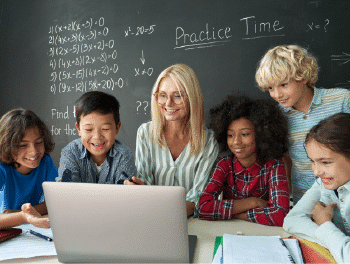10 Things Parents Need To Know
When you are faced with the challenge of obtaining the best education possible for your child with a learning disability, navigating the public school system can feel like a visit to a foreign country.
- The language is different.
- The rules are different.
- The culture is different.
You’ll come to learn about IDEA, LRE, IEP’s, BIP’s, and 504’s.

Take advantage of the online special education resources available as you educate yourself. It’s essential that you recognize your role as an active part of your child’s educational team.
It’s doubly important that you keep at the forefront the INDIVIDUAL component of IEP.
If, at some point in your child’s education, it is recommended that they are placed in a self-contained classroom, do some research before making a decision.
A self-contained classroom refers to a classroom designed for children whose behaviors, learning challenges, or other disabilities prohibit them from succeeding in a mainstream classroom.
There is one special education teacher and one or more assistants in the classroom to serve a small number of children who require more intensive instruction and attention.
10 Things Parents Need To Know About Self Contained Classrooms
Consider the ten points below to help you decide
if a self-contained classroom is the best educational option for your child.
1: Is a move to the self-contained classroom a last resort?
According to the Individuals With Disabilities Act (IDEA), specifically it’s directive to use the “least restrictive environment (LRE),” all children should be included in the general school population as much as possible with reasonable assistance.
There are instances where a child will benefit from time in a self-contained classroom – just make sure it’s after other less-isolating options are explored.
2: See for yourself.
Arrange to visit the classroom your child may be moved to. Spend a full school day observing, if possible.
Note:
- Is the language used by teachers and aides encouraging?
- Are there opportunities for the children to interact with each other and with their typically developing peers?
- What is the overall atmosphere?
3: Find out what the testing requirements will be for your child.
While it varies from state-to-state, all children, including those in self-contained classrooms, are required to take standardized tests.
Before placing your child in such a classroom talk to teachers and other professionals to determine if the emphasis on testing will override the benefits of a contained classroom.
4: What level of training have the teachers and their assistants had?
Self-contained classrooms are generally headed by a teacher with a degree in special education.
While this is more specialized than a regular teaching certificate, it does not guarantee that the teacher will have experience and/or strategies to address your child’s particular challenges.
The same holds true for assistants.
5: Ask about which safety protocols are in place.
Children in self-contained classrooms often have difficulty communicating.
What levels of protection has the school put into place to ensure a transparent and secure classroom.
- Are there security cameras?
- Does the classroom have a “safe” area where children who need time to calm themselves can go?
- What are the procedures for children who need help with personal needs – bathroom, eating, etc.?
6: Learn if “aversives,” restraints or seclusions are regularly used in the classroom being recommended for your child.
“Aversives” are methods of deterring unwanted behavior through negative means.
Aside from the fact that aversives rarely work for any length of time; it is easy for this type of negative feedback to cross the line into abuse if teachers and staff do not have extensive training and experience.
Thirteen states have laws against the use of restraints on school children.
Find out what your state’s policy is and if the school has a history of using restraints. Isolating a child for unwanted behaviors can be dangerous.
Learn your school’s policies and track record before putting your child in a self-contained classroom.
7: Ask about teacher turnover rates.
Special education teachers have a high rate of burn-out – particularly in school systems that do not provide them with a strong support system.
Continuity and consistency are essential for children with special needs – being able to count on the teaching staff is vital for making progress.
8: Determine if teachers are encouraged to develop and implement their own classroom rules based on the population of the classroom.
Having consistent rules that are understood by all of the students and regularly reviewed and reinforced by the teaching staff goes a long way in creating a cohesive, cooperative environment.
Each classroom is unique and, thus, will have their own rules and consequences.
9: Get comfortable with your own position.
There are pros and cons to contained classrooms.
It’s up to you to decide where you stand.
If you feel strongly about all children being included, a self-contained classroom might not be the best fit for your family. If you feel strongly that your child needs the extra attention and room to be themselves, a self-contained classroom might be the transitional solution you’ve been looking for.
Explore all of your options. Don’t rule out using the public school for specialized services and homeschooling the rest of the day. Spend some serious time exploring the special education resources online before coming to a final conclusion.
10. Special education is not a place.
It is a service public schools are obligated to provide to children.
It is NOT a place to send them.
There are multiple ways to help children with special needs. Your job is to find what works best for your child.
It is not your job to make things easier for the school. Learn from others’ experiences.
Use the vast special education resources available online to help you educate your child and to give you ideas of what might or might not work.

You Can Do This
It’s not going to be easy – what worthwhile goal is easy?
Learn from others’ experiences while recognizing that your own situation is unique. When it comes to special education, there is no one-size-fits-all.
Ask questions. Lots of questions.
Do not allow others with titles and degrees to intimidate you or make your head explode with “alphabet” language.
Keep a notebook, take notes. Smile. Leave with your notes and go home and find a search engine and educate yourself.
Then . . . go back with more notes and knowledge and re-start the discussion.
Use the ten tips above as a starting point. Chin up. Shoulders back.
You. Can. Do. This.

Want more information regarding a Self-Contained Classroom
Watch This!
Think Differently About Education. We Believe…


We assess your child’s learning style, personality, and interests to pair them with the ideal special ed tutor based on their individual needs.




Through technology and one on one learning, their future path to success can be made clear again.
Are you ready to see confident progress in your child?
Get started with a no-obligation consultation today!
Copyright © 2025 SpecialEd Resource – Design by DeskTeam360

